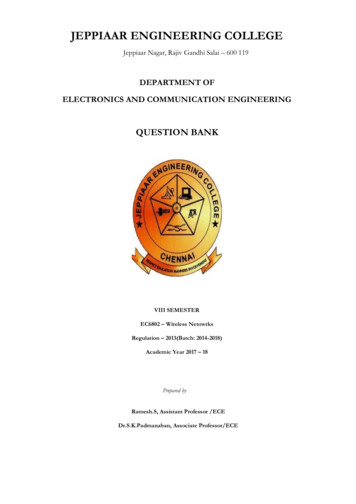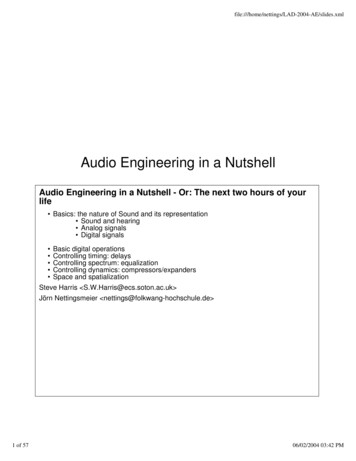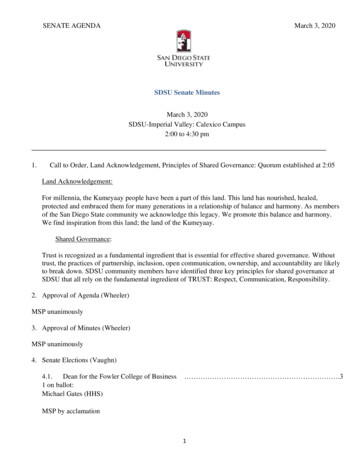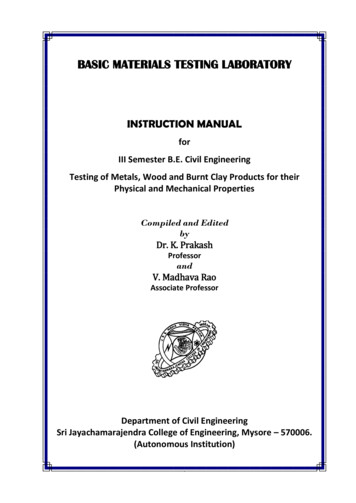
Transcription
JEPPIAAR ENGINEERING COLLEGEJeppiaar Nagar, Rajiv Gandhi Salai – 600 119DEPARTMENT OFELECTRONICS AND COMMUNICATION ENGINEERINGQUESTION BANKVIII SEMESTEREC6802 – Wireless NetowrksRegulation – 2013(Batch: 2014-2018)Academic Year 2017 – 18Prepared byRamesh.S, Assistant Professor /ECEDr.S.K.Padmanaban, Associate Professor/ECE
JEPPIAAR ENGINEERING COLLEGEJeppiaar Nagar, Rajiv Gandhi Salai – 600 119DEPARTMENT OF ELECTRONICS AND COMMUNICATION ENGINEERINGQUESTION BANKSUBJECT: EC6802 – Wireless NetworksYEAR /SEM: IV /VIIIUNIT IWIRELESS LANIntroduction-WLAN technologies: Infrared, UHF narrowband, spread spectrum -IEEE802.11: System architecture,protocol architecture, physical layer, MAC layer, 802.11b, 802.11a – Hiper LAN: WATM, BRAN, HiperLAN2 –Bluetooth: Architecture, Radio Layer, Baseband layer, Link manager Protocol, security - IEEE802.16-WIMAX: Physicallayer, MAC, Spectrum allocation for WIMAX.PART – ACO Mapping :C410.1Q.NoQuestionsBTCompetencePOLevel1State the significance of Radio transmission over infrared. BTL-4 RememberingPO1,P06(April 2017)2OFDM uses a set of orthogonal sub-carriers for transmission ofBTL-3 ApplyingPO1data. OFDM is used in WLANs. Consider an OFDM systemthat uses 52 sub-carriers out of which 48 are pilot sub-carriers.System bandwidth is 20MHz and OFDM symbol durationincluding cyclic prefix is 4µs. If code rate is 3/4 and 64 QAM isused, find the data rate.(April 2017)3Define wireless LANBTL-2 UnderstandingPO1,PO24Explain the Problems with Wireless NetworksBTL-2 UnderstandingPO15Differentiate Infra-red and Radio transmissionBTL-4 AnalyzingPO16What is HIPERLAN?BTL-1 RememberingPO17Give two types of data burst in HIPERLAN?BTL-1 RememberingPO1,PO28Differentiate centralized mode and direct modeBTL-4 AnalyzingPO1,PO29Differentiate between WiFi and WiMAX.BTL-4 AnalyzingPO110What is WLL?BTL-1 RememberingPO111What is Fresnel zone?BTL-1 RememberingPO112What is NIC?BTL-1 RememberingPO113Mention the design goals of WLANsBTL-2 UnderstandingPO1,PO2,PO314What are the different features of MAC Protocols?BTL-4 RememberingPO115What is wireless networking?BTL-1 UnderstandingPO116What is meant by MAC Protocols?BTL-1 RememberingPO117What is meant by spread spectrum?BTL-1 UnderstandingPO218List out the types of spread spectrum?BTL-1 RememberingPO119What is Frequency Hopping Spread Spectrum (FHSS)?BTL-1 RememberingPO1,PO220Give the advantages of spread spectrum over a fixed-frequency BTL-2 CreatingPO1,PO2transmission?21What is direct sequence spread spectrum (DSSS)?BTL-1 RememberingPO1,PO222Give the features of DSSS?BTL-2 RememberingPO1,PO223What is Time-Hopping spread spectrum (THSS)?BTL-1 RememberingPO124List and explain the inter-frame spacingBTL-1 RememberingPO1,PO225What is chirp spread spectrum (CSS)?BTL-1 UnderstandingPO1
262728293012345678What is scatternet?Explain the different types of services offered by Bluetooth?List the functional requirements of HIPERLANS.What is Bluetooth?What is the advantage of piconet /scatternet. erstandingPO1BTL-2UnderstandingPO1Discuss IEEE 802.15 Protocol in detail.BTL-2UnderstandingPO1a. Discuss IEEE 802.15 Protocol in detail.b. Give the significance of BRANExplain HiperLAN in scuss in detail about spread spectrum techniques.BTL-2UnderstandingPO1PART – BExplain and compare the media access control mechanism ofDCF methods adopted in IEEE 802.11 WLAN (April 2017)Describe the architecture and protocol stack of Bluetoothtechnology. (April 2017)Briefly explain about the system and protocol architecture of802.11.Explain in detail about Wifi and WimaxUNIT IIMOBILE NETWORK LAYERIntroduction - Mobile IP: IP packet delivery, Agent discovery, tunneling and encapsulation, IPV6Network layer in the internet- Mobile IP session initiation protocol - mobile ad-hoc network: Routing,Destination Sequence distance vector, Dynamic source routing.PART – ACO Mapping ingPO1234567What is encapsulation and de-capsulation? (April2017)What is a Care of address in Mobile–IP? (April 2017)Define wireless LANDefine an outer header and outer header.Define Home agentWhat are the different terminologies of mobile IP?Mention the different entities in a mobile O1PO1PO1PO1PO1PO189101112What are the key mechanisms in mobile IP?What is the advantage of Infra-red technology?What is meant by mobile IP?What is the different operation of mobile IP?What is meant by generic routing PO1,PO2PO1PO1PO113What are the general problems of mobile IPregarding security and support of quality of service?Define Tunnel?List out the features of Mobile IP?What are the types of care of address?Define Ad hoc wireless network with example?Differentiate wired networks and adhoc wirelessnetworks based on routing.What is agent advertisement?What is eringRememberingPO1,PO2PO1,PO2114151617181920PO
21222324252627282930123456789Give examples for mobile adhoc networks.What is DHCP?Differentiate infrastructure and ad-hoc networks.What is roaming?What is SIP?What are the functions of Session Initiation Protocol(SIP)?Differentiate an ad hoc network and a cellularnetwork .Differentiate proactive and reactive routing protocols.Write examples for eachGive the classifications of routing protocol inMANET.Explain agent advertisement?PART – BExplain and compare the working mechanism of bothDestination sequence distance vector (DSDV) andDynamic source routing protocol when applied on amobile ad-hoc network scenario. (April 2017)State the entities and terminologies used in Mobile IPalong with tunneling and also explain the three typesof encapsulation mechanisms used in mobile IP.(April 2017)Discuss in brief about the IP packet deliveryDescribe in detail the registration procedure.Briefly discuss about agent discovery in mobile-IPExplain in detail the Dynamic host configurationprotocol.Discuss the routing protocols in MANETDescribe IPV6 in detail with its extension headers.Explain Mobile IP-SIP in detailDiscuss in detail how packets are routed in MANETusing Dynamic source routing algorithm.UNIT 2BTL-2UnderstandingPO1,PO2MOBILE TRANSPORT LAYERTCP enhancements for wireless protocols - Traditional TCP: Congestion control, fast retransmit/fast recovery,Implications of mobility - Classical TCP improvements: Indirect TCP, Snooping TCP, Mobile TCP, Time outfreezing, Selective retransmission, Transaction oriented TCP - TCP over 3G wireless networks.PART – ACO Mapping What is M-TCP? Give the advantages of M-TCP.(April 2017)List the disadvantages of I-TCP. (April 2017)What is I-TCP?What are all the various flavor‘s of TCP available?What led to the development of Indirect TCP?What is BOOTP?What is Snooping TCP?Define Routers.What is the goal of M-TCP?What are the different layers of O2PO1PO1
11Differentiate types of Care of address.BTL-1RememberingPO112Define Agent solicitationBTL-1RememberingPO113What is selective re-transmission?BTL-2UnderstandingPO114What is meant by a binding cache?BTL-2UnderstandingPO115What is the basic purpose of DHCP?BTL-2UnderstandingPO116How does I-TCP isolate problems on the wirelesslink?BTL-2UnderstandingPO117What is time out freezing?BTL-2UnderstandingPO218What are the possible locations for care of address?BTL-2UnderstandingPO119What is triangular 20What is slow start mechanism?21What is Fast Retransmit algorithm in TCP?BTL-2UnderstandingPO122What is Congestion Avoidance algorithm?BTL-2UnderstandingPO123What are the techniques for classical improvements?BTL-2UnderstandingPO1,PO2,PO324What are the advantages and disadvantages of I – BTL-2TCP?What are the advantages and disadvantages of Mobile hat is Snooping TCP?BTL-2UnderstandingPO1,PO227What is time-out PO129What are the advantages and disadvantages of timeout freezing?What is Selective RetransmissionBTL-2UnderstandingPO130What are the applications of andingPO1BTL-2UnderstandingPO1PART B12345Write your understanding on indirect TCP, SnoopingTCP, Mobile TCP and transaction oriented TCP.(April 2017)Describe the working mechanism of Traditional TCP.(April 2017)Explain the traditional TCP .What are theimprovements that are made into the classical TCP?(a)Discuss how Snooping TCP acts as a TransparentTCP and explain the role of foreign agent in it indetail.(b)What happens in the case of I-TCP if the mobile isdisconnected? DiscussWrite notes on Mobile TCP and transaction orientedTCP in detail
6789101112Discuss in brief the pros and cons of Snooping TCPBTL-2UnderstandingPO1Elaborate on classical enhancements to TCP formobilityDescribe the benefits and shortcomings of MobileTCPExplain in detail how TCP is optimized for 3Gwireless networks?Write short notes on time-out freezing and selectivere-transmission.Write your understanding on indirect TCP, SnoopingTCP, Mobile TCP and transaction oriented TCP.Write short notes on time-out freezing and 1UNIT IVWIRELESS WIDE AREA NETWORKOverview of UTMS Terrestrial Radio access network-UMTS Core network Architecture: 3G-MSC, 3GSGSN, 3GGGSN, SMS-GMSC/SMS-IWMSC, Firewall, DNS/DHCP-High speed Downlink packet access (HSDPA)- LTE networkarchitecture and protocol.PART – ACO Mapping t is the role of firewall used in UMTS network? (April BTL-2 Understanding2017)2PO1Name the 3G radio access schemes identified to support BTL-1 Rememberingdifferent spectrum scenario. (April 2017)3PO1,PO2List the sub-systems of UMTS Terrestrial Radio Access BTL-1 RememberingNetwork (UTRAN).4BTL-1 RememberingPO1State the responsibilities of an RNC5BTL-1 RememberingPO1State the responsibilities of Node B6BTL-2 UnderstandingPO1What is the need for Iu interface?7BTL-4 AnalyzingPO1,PO2Draw the UTRAN logical architecture.8BTL-1 RememberingPO1,PO2State the three different protocol planes of Iu interface9BTL-1 RememberingPO1List the functions of RNCP.10BTL-2 UnderstandingPO1What is the need for Iur interface11BTL-2 UnderstandingPO1What are the functions carried out by Iur interface?12BTL-2 UnderstandingPO1What is the need for Iub interface?13BTL-1 RememberingPO1,PO2State the functionality of Uu interface.14BTL-1 RememberingPO1State the functions of 3G-MSC15BTL-1 RememberingPO1Write about 3G-SGSN16BTL-4 AnalyzingPO1Draw UMTS core network architecture17BTL-1 UnderstandingPO2List the functions of 3G-GGSN18BTL-2 UnderstandingPO1What are the tasks carried out by SMS-GMSC?19BTL-2 UnderstandingPO1Why do we need Firewall in a network?20BTL-1 RememberingPO1,PO3Write about DNS.21BTL-1 RememberingPO1,PO2List out the need for DHCP.22BTL-1 RememberingPO1,PO2State the salient features of HSDPA.23BTL-2 UnderstandingPO1What is Transport Network Control Plane (TNCP)?24BTL-2 UnderstandingPO1What is 3G-SGSN?25BTL-2 UnderstandingPO1What are the functions provided by 3G-GGSN?26BTL-2 UnderstandingPO1What is SMS-GMSC?27BTL-2 UnderstandingPO1What is radio resource control (RRC)?28BTL-2 UnderstandingPO1What are the duties of Radio network control (RNC)?29BTL-2 UnderstandingPO1What are the planes of UTRAN?30BTL-4 RememberingPO1What are the functions provided by 3G-MSC?1PART BElaborate on UMTS core network architecture with a neatsketch(April 2017)BTL-2UnderstandingPO1
2345678Explain the UMTS network architecture with GSM,3G and alsoexplain the reference architecture (April 2017)Explain in detail about UTRAN Logical Architecture with aneat sketchDescribe the distribution of UTRAN functions in RNC andNode BDiscuss the salient features of HSDPA with respect to physicallayerExplain LTE network architecture and associated protocols indetail.Explain the functions performed by 3G-SGSN and erstandingPO1BTL-2UnderstandingPO1Explain the concepts of UMTS network Qos Service and itsmanagement.BTL-2UnderstandingPO1UNIT V 4G NETWORKSIntroduction – 4G vision – 4G features and challenges - Applications of 4G – 4G Technologies:Multicarrier Modulation, Smart antenna techniques, OFDM-MIMO systems, Adaptive Modulation and coding with timeslot scheduler, Cognitive RadioPART – ACO Mapping :C410.5Q.NoQuestionsBTCompetencePOLevel1BTL-1 RememberingPO1,P06List the key features of 4G networks from the user point ofview. (April 2017)2BTL-2 UnderstandingPO1What is multi carrier modulation? Mention its advantages.(April 2017)3BTL-4 AnalyzingPO1,PO2Differentiate between 3G and 4G networks4BTL-2 UnderstandingPO1What is the data rate offered by 4G systems?5BTL-2 UnderstandingPO1What are the applications of 4G technology?6BTL-5 EvaluatingPO1Mention the challenges faced by 4G networks7BTL-1 RememberingPO1,PO2What are the types of multi carrier modulation?8BTL-2 UnderstandingPO1Explain the concept of Multiple Input Multiple Output(MIMO)?9BTL-1 RememberingPO1Give the capacity equation for Single Input Single output(SISO) system.10BTL-2 UnderstandingPO1Explain briefly the concept of MIMO-OFDM systems in detail.11BTL-2 UnderstandingPO1Explain briefly the concept of Bell Lab Layered Space Time(BLAST) architecture12BTL-4 AnalyzingPO1How efficient packet data transmission can be achieved in 4Gnetworks?13BTL-2 UnderstandingPO1,PO2,What is Software Defined Radio (SDR)?PO314BTL-1 RememberingPO1List out the features of 4G networks?15BTL-1 AnalyzingPO1Sketch the block diagram of MIMO system16Sketch the architecture of BLAST systemBTL-4AnalyzingPO117List out the various advantages of SDR technologyBTL-1UnderstandingPO218192021What is Cognitive Radio? Mention any one applicationExplain services provided by 4G?What are the main functions of Cognitive Radio?Define Cognitive 22324What is meant by MIMO?What are the benefits of Smart Antenna Technology?Mention the hardware components of Software Defined Radio?PART BWrite your understanding on behaviour of smart antennatechniques(April 2017)Explain in detail about Adaptive modulation and Coding withtime slot scheduler in detail(April rstandingPO112
345678Explain motivation behind the evolution of 4G technology indetailExplain the key challenges faced by 4G networks and alsopropose solutions of how to mitigate those challenges.Explain the concept of Multi carrier modulation (MCM) indetail.With a neat block diagram explain the concept of BLASTarchitecture in detailExplain in detail about Software Defined Radio standingPO1Explain the concept of Cognitive Radio and enumerate in detailits role in field of spectrum sensing by highlighting itsbottlenecks.BTL-2UnderstandingPO1UNIT I - WIRELESS LANPART A1. State the significance of Radio transmission over infrared. (April 2017)Radio transmissionInfrared(i) Coverage rangeUpto 50m for LOSUpto 10m(ii) Data rate100kbps500bps-1kbps(iii) Power consumption5-20 mW during ON state20-150 mW during ON state2. OFDM uses a set of orthogonal sub-carriers for transmission of data. OFDM is used in WLANs. Consider anOFDM system that uses 52 sub-carriers out of which 48 are pilot sub-carriers. System bandwidth is 20MHz andOFDM symbol duration including cyclic prefix is 4µs. If code rate is 3/4 and 64 QAM is used, find the data rate.(April 2017)Data rate ;For 64-QAM Bits Per symbol 6with ¾ code rate, No of bits / subcarrier 6*3/4 4.5Total No. of bits for 48 sub carriers 4.5 * 48 216 bits/symbol;Data rate 216/4µs 54Mbps.3. Define wireless LAN.Local area and Built on exiting wireless communication networks and Allows cellular phone access to Internetservices4. Explain the Problems with Wireless Networks Operates in a less controlled environment, so is more susceptible to interference, signal loss, noise, andeavesdropping. Generally, wireless facilities have lower data rates than guided facilities. Frequencies can be more easily reused with guided media than with wireless media.5. Differentiate Infra-red and Radio transmission.Two different basic transmission technologies can be used to set up WLANs. One technology is based on the transmissionof infra-red light the other one, which is much more popular, uses radio transmission Both technologies can be used to setup ad-hoc connections for work groups, to connect, e.g., a desktop with a printer without a wire, or to support mobilitywithin a small area.The main advantages of infra-red technology are its simple and extremely cheap senders and receivers.Disadvantage of infra-red transmission is low bandwidth. Advantages of radio transmission include the long-termexperiences made with radio transmission for wide area networks. The main advantage is also a big disadvantage of radiotransmission. Shielding is not so simple.6. What is HIPERLAN?HIPERLAN is a set of wireless local area network communication standards primarily used in Europeancountries. It has four specifications: HIPERLAN1, HIPERLAN2, HIPERLINK and HIPERACCESS.7. Give two types of data burst in HIPERLAN?The transmission format on the physical layer is a burst, which consists of a preamble and a data part. Fivedifferent PHY bursts have been defined: broadcast, downlink, uplink with short preamble, uplink with long preamble, anddirect link (optional). The bursts differ in their preambles.8. Differentiate centralized mode and direct mode.Centralized mode is based on infrastructure based mode. APs are associated with mobile terminals and all data istransferred between the two terminals via AP.Direct mode is based on ad-hoc mode. Here data is directly exchangedbetween mobile terminals.9. Differentiate between WiFi and WiMAX.WiMAX and Wi-Fi are both wireless broadband technologies, but they differ in the technical execution. Wi-Fiwas developed to be used for mobile computing devices, such as laptops, in LANs, but is now increasingly used for moreservices, including Internet and VoIP phone access, gaming, and basic connectivity of consumer electronics such as
televisions and DVD players, or digital cameras. On the other hand WiMAX was developed as a standards-basedtechnology enabling the delivery of last mile wireless broadband access as an alternative to cable and DSL.10. What is WLL?Wireless local loop (WLL), is a term for the use of a wireless communications link. As subscribers havedemanded greater capacity, particularly to support internet use traditional twisted pair tech has become inadequate.Interest being shown in competing wireless technologies for subscriber access. These generally referred to as WLL orfixed wireless access. Mainly used in Urban and rural areas.11. What is Fresnel zone?For effective communication at millimeter wavelength, there should be an unobstructed line of sight betweentransmitter and receiver. In this, if there are any obstacles near the path then it will reduce the power of the received signal(i.e.) increases signal to noise ratio. Fresnel Zone provided a mean to calculate where the zones are, where a givenobstacle will cause mostly in phase or mostly out of phase reflections b/w the transmitter and receiver.12. What is NIC?A PC or workstation uses a wireless NIC to connect to the wireless network. The NIC scans the availablefrequency spectrum for connectivity and associates it to an access point or another wireless client. The NIC is coupled tothe PC/workstation operating system using a software driver.13. Mention the design goals of WLANs. Global operation: LAN equipment may be carried from one country to another and this operation should be legal(frequency regulations national and international). Low power: Take into account that devices communicating via WLAN are typically running on battery power. Specialpower saving modes and power management functions. Simplified spontaneous co-operation: no complicated setuproutines but operate spontaneously after power. Easy to use: WLANs are made for simple users; they should not require complex management but rather work on aplug-and-play basis. Protection of investment: A lot of money has been invested for wired LANs, WLANs should be able to interoperatewith existing network (same data type and services). Safety and security: Safe to operate. Encryption mechanism, do not allow roaming profiles for tracking people(privacy) Transparency for applications: Existing applications should continue to work.14. What are the different features of MAC Protocols? It should implement some rules that help to enforce discipline when multiple nodes contend for a shared channel. It should help maximize the utilization of the channel Channel allocation needs to be fair. It should be capable of supporting several types of traffic having different maximum and average bit rates.15. What is wireless networking?Wireless refers to the method of transferring information between a computing device, and a data source, such asan agency database server, without a physical connection16. What is meant by MAC Protocols?When an IP packet reaches its destination (sub) network, the destination IP address (a layer 3 or network layerconcept) is resolved with the Address Resolution Protocol for IPv4, or by Neighbor Discovery Protocol (IPv6) into theMAC address (a layer 2 concept) of the destination host.17. What is meant by spread spectrum?In telecommunication and radio communication, spread-spectrum techniques are methods by which a signal(e.g. an electrical, electromagnetic, or acoustic signal) generated with a particular bandwidth is deliberately spread in thefrequency domain, resulting in a signal with a wider bandwidth.18. List out the types of spread spectrum?Frequency Hopping Spread Spectrum (FHSS), Direct-sequence spread spectrum (DSSS) , Time Hopping spreadspectrum (THSS) and Chirp spread spectrum (CSS)19. What is Frequency Hopping Spread Spectrum (FHSS)?Frequency Hopping Spread Spectrum (FHSS) is a method of transmitting radio signals by rapidly switchinga carrier among many frequency channels, using a pseudorandom sequence known to both transmitter and receiver. It isused as a multiple access method in the frequency-hopping code division multiple access (FH-CDMA) scheme.20. Give the advantages of spread spectrum over a fixed-frequency transmission? Spread-spectrum signals are highly resistant to narrowband interference. The process of re-collecting a spreadsignal spreads out the interfering signal, causing it to recede into the background. Spread-spectrum signals are difficult to intercept. A spread-spectrum signal may simply appear as an increase inthe background noise to a narrowband receiver. An eavesdropper may have difficulty intercepting a transmissionin real time if the pseudorandom sequence is not known. Spread-spectrum transmissions can share a frequency band with many types of conventional transmissions withminimal interference. The spread-spectrum signals add minimal noise to the narrow-frequency communications,and vice versa. As a result, bandwidth can be used more efficiently.21. What is direct sequence spread spectrum (DSSS)?DSSS systems transmit the message bearing signals using a bandwidth that is in excess of the bandwidth that isactually needed by the message signal. This spreading of the transmitted signal over a large bandwidth makes the
resulting wide band signal to appear as a noise signal which allows greater resistance to intentional and unintentionalinterference with the transmitted signal.22. Give the features of DSSS?DSSS phase-shifts a sine wave pseudo randomly with a continuous string of pseudo-noise (PN) code symbolscalled "chips", each of which has a much shorter duration than an information bit. That is, each information bit ismodulated by a sequence of much faster chips. Therefore, the chip rate is much higher than the information signal bit rate.DSSS uses a signal structure in which the sequence of chips produced by the transmitter is already known by the receiver.The receiver can then use the same PN sequence to counteract the effect of the PN sequence on the received signal inorder to reconstruct the information signal.23. What is Time-Hopping spread spectrum (THSS)?Time-hopping (TH) is a communications signal technique which can be used to achieve anti-jamming (AJ)or low probability of intercept (LPI). It can also refer to pulse-position modulation, which in its simplest formemploys 2k discrete pulses (referring to the unique positions of the pulse within the transmission window) totransmit k bit(s) per pulse. To achieve LPI, the transmission time is changed randomly by varying the period andduty cycle of the pulse (carrier) using a pseudo-random sequence. The transmitted signal will then haveintermittent start and stop times. Although often used to form hybrid spread-spectrum (SS) systems,24. List and explain the inter-frame spacing. SIFS (Shortest inter-frame spacing) - It has the highest priority because it has the shortest waiting time formedium access. And it is defined for Short control messages. PIFS (PCF inter frame spacing)-It has medium priority because it has a waiting time between DIFS and SIFS. Itis used for a time bounded service. DIFS (DCF inter frame spacing)-This parameter denotes the longest waiting time and has the lowest priority formedium access.25. What is chirp spread spectrum (CSS)?In digital communications, chirp spread spectrum (CSS) is a spread spectrum technique that uses widebandlinear frequency modulated chirp pulses to encode information. A chirp is a sinusoidal signal whose frequency increasesor decreases over time (often with a polynomial expression for the relationship between time and frequency). In thepicture is an example of an up chirp—as you can see, the frequency increases linearly over time.26. What is scatternet?Bluetooth enabled devices are organized in groups called piconets. One device in the piconet can act as master;all other devices connected to the master must act as slaves. A master unit is the device that initiates the communication.As more users join the piconets, the throughput per user drops quickly. So they move on to scatternet. It consists of twopiconets both having different hopping sequences.27. Explain the different types of services offered by Bluetooth?Basic profiles have been specified as: Generic access, service discovery, cordless telephony, intercom, serialport, headset, dialup networking, LAN access, generic object exchange, object push, file transfer, and synchronization.Additional profiles are: Advanced audio distribution, PAN, audio video remote control, basic printing, basic imaging,extended service discovery, generic audio video distribution, hands-free, and hardcopy cable replacement. Each profileselects a set of protocols.28. List the functional requirements of HIPERLANS. Data rates of 23.529 Mbps Support both synchronous and asynchronous traffic Power saving support, Video at 2 Mbps, 100 ns latency and audio at 32 Kbps, 10 ns latency to coveragemultihub features Low mobility of 1.4 m/s Support of time bound services Asynchronous file transfer at 13.4 Mbps29. What is Bluetooth?Bluetooth is an inexpensive personal area Ad-hoc network operating in unlicensed bands and owned by the user. It isan open specification for short range wireless voice and data communications that was developed for cable replacement inPAN (Personal Area Network).30. What is the advantage of piconet /scatternet. ?The advantage of the Piconet / Scatternet scheme is that it allows many devices to share the same physical area andmake efficient use of bandwidth.1.2.PART BExplain and compare the media access control mechanism of DCF methods adopted in IEEE 802.11 WLAN (April2017).Refer P.No.214, ―Mobile Communications‖, by Jochen Schiller, Pearson Education 2012Describe the architecture and protocol stack of Bluetooth technology. (April 2017)
3.4.5.6.7.8.Refer P.No.269, ―Mobile Communications‖, by Jochen Schiller,Pearson Education 2012Briefly explain about the system and protocol architecture of 802.11.Refer P.No.210, ―Mobile Communications‖, by Jochen Schiller, Pearson Education 2012Refer P.No.211, ―Mobile Communications‖, by Jochen Schiller, Pearson Education 2012.Explain in detail about Wifi and Wimax.Refer P.No.231, ―Mobile Communications‖, by Jochen Schiller, Pearson Education 2012.Discuss IEEE 802.15 Protocol in detail.Refer P.No.291, ―Mobile Communications‖, by Jochen Schiller, Pearson Education 2012.(a) Describe spectrum allocation for WiMAX
3 Define wireless LAN BTL-2 Understanding PO1,PO2 4 Explain the Problems with Wireless Networks BTL-2 Understanding PO1 5 Differentiate Infra-red and Radio transmission BTL-4 Analyzing PO1 6 What is HIPERLAN? BTL-1 Remembering PO1 7 Give two t










